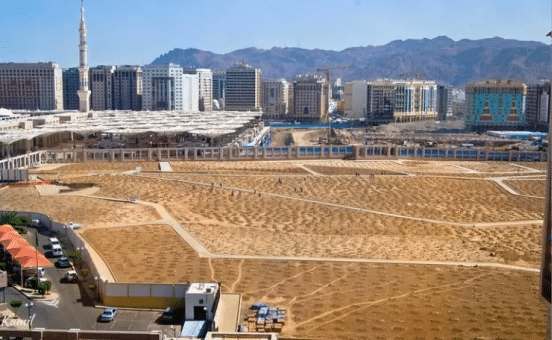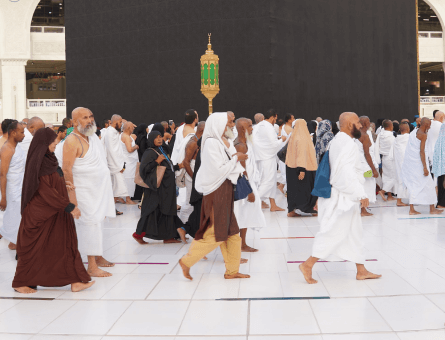What is Farewell Tawaf? How To Perfrom Tawaf Al-Wada & It’s Importance in Islam
Also known as Tawaf Al-Wada, the Farewell Tawaf is to be performed after the completion of Hajj right before a pilgrim is leaving Makkah, Saudi Arabia. In order to perform Tawaf Al-Wada, Muslims are directed to circumambulate the Holy Kaaba seven times and pray two Rakats (only if one wants to, as it is not mandatory). The Farewell Tawaf only applies to Hajj and not Umrah, and it does not include Saee (running in between mount Safa and Marwa seven times).
Note that the Farewell Tawaf should be performed at the very end of Hajj, only after a pilgrim has completed all the rituals, actions, and responsibilities. Read on to learn more about the Farewell Tawaf.
What Is Farewell Tawaf during Hajj?
Farewell Tawaf is the last ritual a pilgrim must perform before leaving the holy city of Makkah on completion of Hajj. It is an essential ritual and should be practised by encircling the Holy Kaaba seven times. However, the Farewell Tawaf is only Wajib for those who have travelled for Hajj from outside the boundaries of Miqat. Therefore, those living within the premises of Miqat aren’t obligated to perform Tawaf Al-Wada.
The significance of the Farewell Tawaf is evident from the following hadith of Prophet Muhammad (PBUH): “The people were ordered to circumambulate the Kaaba as the last thing they should do in Makkah, but an exception is for menstruating women.” (Bukhari: 1755, Muslim: 1328)
Tawaf Al-Qudum
Tawaf Al-Qudum means the “Tawaf of Arrival.” The Welcome Tawaf is carried out upon entering the Grand Mosque by those performing Hajj Al-Ifrad and Hajj Al-Qiran. Pilgrims are directed to wear Ihram while performing the Welcome Tawaf. Moreover, it is a Sunnah for men to perform Idtiba (uncovering of the right shoulder) and Raml (pacing oneself for the first three rounds) during Tawaf Al-Qudum.
What Is Tawaf Al-Wada?
Tawaf Al-Wada means “The Farewell Tawaf.” It is to be performed by the pilgrim just before exiting the House of Allah SWT, Makkah, Saudi Arabia, after completing the Hajj. Being the final rite of Hajj, it is mandatory to perform Tawaf Al-Wada before moving on to the next destination. The purpose of the Tawaf Al-Wada is to bid farewell to the House of Allah SWT.
“ It is obligatory for every Muslim who has travelled to Makkah with the intention of Hajj to perform Tawaf Al-Wada, except for residents of Makkah and menstruating women.”
Here are some hadith in light of Tawaf Al-Wada:
Ibn Abbas (RA) narrated Prophet Muhammad (PBUH) after observing that Muslims used to head out in every direction after completion of Hajj, directed that when a person has finished all that he has to do and has decided to travel, then he has to perform Farewell Tawaf around the Holy Kaaba. Allah SWT’s Messenger (PBUH) said, “None of you should depart until he makes as his last act Tawaf of the House.” [Al-Bukhari, 1755]
In another event, Ibn Abbas (RA) said, “And the menstruating woman was first ordered to wait until she became clean of it to make Tawaf al-Wada. Then it was permitted for her to leave without waiting.” He said it in reference to the hadith of Prophet Muhammad (PBUH), in which the beloved Messenger (PBUH) of Allah SWT gave concession for the menstruating women that she should depart before Farewell Tawaf as long as she had made Tawaf of Ifadah. [Al-Bukhari, 1755]
What Is Tawaf Al Ifadha?
Otherwise known as Tawaf Al Ziyarah, Tawaf Al Ifadha is performed on the 10th of Dhul Hijjah after completing the ritual of sacrifice, shaving the head, and leaving the state of Ihram. Tawaf Al Ifadha should be practised anytime from the morning of the 10th of Dhul Hijjah to sunset on the 12th of Dhul Hijjah. Note that a pilgrim isn’t required to wear Ihram during Tawaf Al-Ifadha.
How to Perform Tawaf
Tawaf is derived from the Arabic word “Tauf,” which means to go round and round. It is a mandatory ritual during Hajj and Umrah. Tawaf can be defined as the act of circumambulating the Holy Kaaba seven times in an anti-clockwise direction. Keep reading to learn how to perform Tawaf, as prescribed by Prophet Muhammad (PBUH):
- Observe ablution before entering Masjid Al-Haram. This includes performing Wuddu and getting rid of all minor and major impurities.
- Both women and men must ensure that the Ihram properly covers their bodies.
- Make niyat and enter the state of Ihram at the Miqat.
- As soon as you enter Masjid Al-Haram, start performing the Tawaf from the Black Stone (Hajr Al-Aswad) in an anti-clockwise direction. Stand with your face towards the Holy Kaaba, Hajr Al-Aswad on your right, and make the niyat (intention) to perform Tawaf. Note that the Tawaf must begin and end at the Black Stone.
- Perform Istilam or gesture towards Hajr Al-Aswad while reciting “Bismillahi Wallahu Akbar.” Once done, start the Tawaf in the anti-clockwise direction.
- While performing Tawaf, make sure not to enter the Hateem as it’s a part of the Kaaba.
- One Tawaf is completed when you come back to Hajr Al-Aswad. Therefore, remember to perform Istilam while facing the Black Stone after every Tawaf.
- After completing the Tawaf, move towards the Station of Ibrahim (Maqam-e-Ibrahim) to offer two rakats Salah al-Tawaf.
Why Do Muslims Make Tawaf?
Tawaf is an expression of true love from the heart of a Muslim towards Allah SWT. It’s akin to prayer; an act of worship that brings one closer to Allah SWT. The act of Tawaf demonstrates the unity of the believers of Allah SWT.
It portrays that everyone is equal in the eyes of the Almighty. Muslims perform the Tawaf in a certain way because Allah SWT directed them to do so. During Hajjat ul-Wida, Prophet Muhammad (PBUH) told his Ummah, “Learn your pilgrimage rituals from me.” Since then, all the rituals of Hajj have been performed in the same way the Messenger (PBUH) of Allah SWT practised.
By performing Tawaf, we are able to refocus on the centrality of the spiritual focus that we also have while completing other forms of worship including the daily prayers.
Is Tawaf Mandatory during Hajj?
Yes, Tawaf being an act of worship, is mandatory for all pilgrims (men and women). Your Umrah or Hajj will be incomplete if you do not perform Tawaf. Prophet Muhammad (PBUH) said, “The tawaf is a prayer, except that God has made it lawful for us to speak while doing it. He who talks, then, must only say what is good.”
Summary – Farewell Tawaf
Performing Farewell Tawaf or Tawaf Al-Wada is mandatory (Wajib) for pilgrims who have come to perform Hajj or Umrah from outside the Miqat boundaries. On the other hand, for those living within the limits of Miqat, there’s no obligation to offer the Farewell Tawaf.
Explore The New Pilgrim App
The Ultimate App
for Hajj and Umrah!














